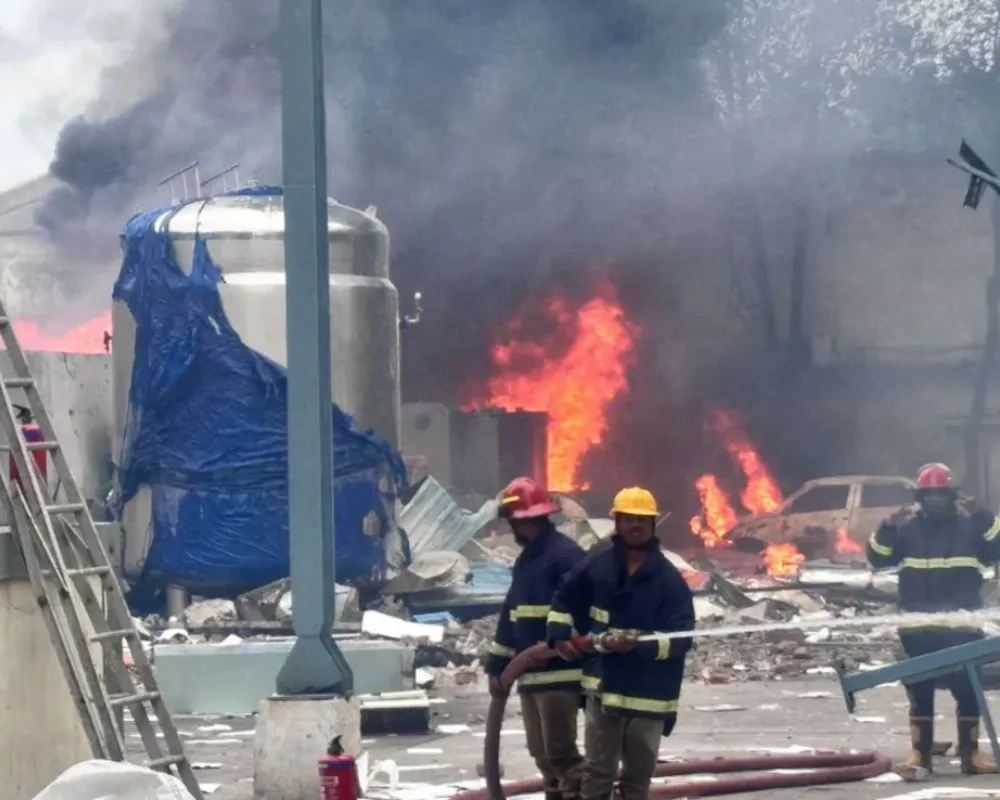A massive explosion at Sigachi Industries in Sangareddy, Telangana, has tragically killed over 45, mostly migrant workers. The ongoing investigation probes safety lapses and faulty machinery.
 Manish Saini
Manish Saini

A devastating explosion and subsequent fire at the Sigachi Industries chemical factory in the Pashamylaram industrial area of Sangareddy district, Telangana, on Monday, June 30, 2025, has resulted in a horrific loss of life. As of Tuesday, July 15, 2025, the death toll has tragically climbed to 45, with many more injured and some still feared missing. The scale of the disaster has sent shockwaves across the state and brought renewed scrutiny on industrial safety standards in the region.
The blast, which occurred around 9:00 AM, ripped through the Sigachi Industries plant, manufacturing Microcrystalline Cellulose (MCC), a key pharmaceutical excipient. The sheer force of the explosion was so immense that it leveled the multi-story production shed, scattering human remains over a wide area and making identification a harrowing challenge. Witnesses reported hearing the deafening sound for kilometers, and some workers were reportedly thrown over 100 meters due to the blast wave.
Rescue operations, involving NDRF, SDRF, police, and fire departments, have been relentless. Recovery efforts continue, with teams sifting through debris to find human remains. Due to the severe nature of the blast and the condition of the recovered bodies, many have been charred or dismembered beyond recognition. Authorities have had to rely heavily on DNA fingerprinting to identify the victims and return them to their grieving families, a process described as even more challenging than identifying victims in air crash incidents due to the scattered nature of the remains and lack of immediate attendance records.
The majority of the victims were migrant workers from states like Bihar, West Bengal, and Uttar Pradesh, who often work long shifts for modest wages. The manual attendance records at the gate were destroyed in the blast, complicating the initial count of those present. It took over a day for police and revenue teams to piece together attendance records, confirming that 143 workers were present at the time, with 57 having returned home unharmed and the rest either injured, deceased, or missing.
One of the key figures lost in the tragedy was M.E. Elanghovan, Sigachi's Vice-President of Operations, who possessed firsthand knowledge of the roster, further hindering initial identification efforts. Families like that of 25-year-old Sunil from Andhra Pradesh and Irfan Ansari (22) from Jharkhand have faced an unbearable wait for closure, as their loved ones are presumed dead but remains are yet to be found or identified. On Monday, July 14, 2025, Tarak (45) from West Bengal became the 45th fatality, succumbing to over 75% burn injuries.
While the exact cause of the blast is still under official investigation, preliminary theories and expert opinions point towards an explosion originating in the dryer unit, likely due to pressure build-up and/or a dust explosion involving fine MCC particles. Initial reports of a "reactor blast" were later clarified by the company, stating the accident was not caused by a reactor.
An FIR has been registered against Sigachi Industries following complaints from a deceased worker's son, Sai Yashwanth, whose father, Venkat Jagan Mohan, had worked at the factory for nearly two decades. Sai Yashwanth alleged that his father and other workers had repeatedly approached the management about "old machinery" and maintenance issues.
The investigation, being conducted by the Factories Department and a state-appointed panel, is probing various aspects, including:
Telangana Chief Minister Revanth Reddy visited the blast site on July 1 and expressed deep condolences, assuring stringent action against those responsible. The state government has announced ex-gratia compensation for the deceased and medical aid for the injured.
The Sigachi Industries tragedy is not an isolated incident but rather the latest in a troubling string of industrial accidents in Telangana, particularly within its chemical and pharmaceutical industrial corridors. This recurring pattern raises urgent and critical questions about:
The Sigachi Industries blast serves as a grim wake-up call, demanding a thorough and unbiased investigation to ascertain the root causes and implement fundamental changes in industrial safety practices and regulatory mechanisms across Telangana and indeed, the nation. Only then can the lives lost in this preventable tragedy truly serve as a catalyst for meaningful reform.






Sign up for the Daily newsletter to get your biggest stories, handpicked for you each day.
 Trending Now! in last 24hrs
Trending Now! in last 24hrs